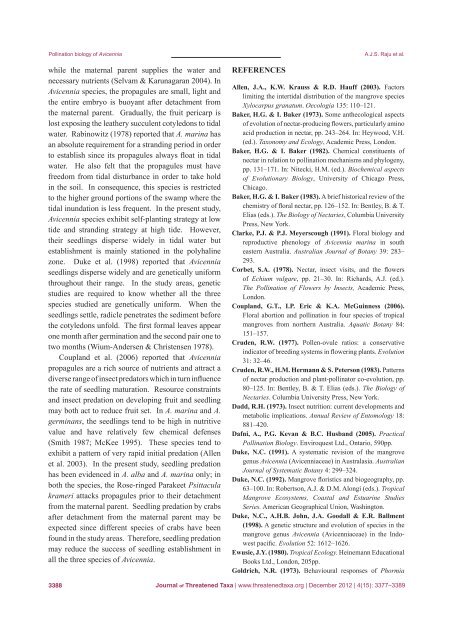December 2012 - Journal of Threatened Taxa
December 2012 - Journal of Threatened Taxa
December 2012 - Journal of Threatened Taxa
You also want an ePaper? Increase the reach of your titles
YUMPU automatically turns print PDFs into web optimized ePapers that Google loves.
Pollination biology <strong>of</strong> Avicennia<br />
while the maternal parent supplies the water and<br />
necessary nutrients (Selvam & Karunagaran 2004). In<br />
Avicennia species, the propagules are small, light and<br />
the entire embryo is buoyant after detachment from<br />
the maternal parent. Gradually, the fruit pericarp is<br />
lost exposing the leathery succulent cotyledons to tidal<br />
water. Rabinowitz (1978) reported that A. marina has<br />
an absolute requirement for a stranding period in order<br />
to establish since its propagules always float in tidal<br />
water. He also felt that the propagules must have<br />
freedom from tidal disturbance in order to take hold<br />
in the soil. In consequence, this species is restricted<br />
to the higher ground portions <strong>of</strong> the swamp where the<br />
tidal inundation is less frequent. In the present study,<br />
Avicennia species exhibit self-planting strategy at low<br />
tide and stranding strategy at high tide. However,<br />
their seedlings disperse widely in tidal water but<br />
establishment is mainly stationed in the polyhaline<br />
zone. Duke et al. (1998) reported that Avicennia<br />
seedlings disperse widely and are genetically uniform<br />
throughout their range. In the study areas, genetic<br />
studies are required to know whether all the three<br />
species studied are genetically uniform. When the<br />
seedlings settle, radicle penetrates the sediment before<br />
the cotyledons unfold. The first formal leaves appear<br />
one month after germination and the second pair one to<br />
two months (Wium-Andersen & Christensen 1978).<br />
Coupland et al. (2006) reported that Avicennia<br />
propagules are a rich source <strong>of</strong> nutrients and attract a<br />
diverse range <strong>of</strong> insect predators which in turn influence<br />
the rate <strong>of</strong> seedling maturation. Resource constraints<br />
and insect predation on developing fruit and seedling<br />
may both act to reduce fruit set. In A. marina and A.<br />
germinans, the seedlings tend to be high in nutritive<br />
value and have relatively few chemical defenses<br />
(Smith 1987; McKee 1995). These species tend to<br />
exhibit a pattern <strong>of</strong> very rapid initial predation (Allen<br />
et al. 2003). In the present study, seedling predation<br />
has been evidenced in A. alba and A. marina only; in<br />
both the species, the Rose-ringed Parakeet Psittacula<br />
krameri attacks propagules prior to their detachment<br />
from the maternal parent. Seedling predation by crabs<br />
after detachment from the maternal parent may be<br />
expected since different species <strong>of</strong> crabs have been<br />
found in the study areas. Therefore, seedling predation<br />
may reduce the success <strong>of</strong> seedling establishment in<br />
all the three species <strong>of</strong> Avicennia.<br />
References<br />
A.J.S. Raju et al.<br />
Allen, J.A., K.W. Krauss & R.D. Hauff (2003). Factors<br />
limiting the intertidal distribution <strong>of</strong> the mangrove species<br />
Xylocarpus granatum. Oecologia 135: 110–121.<br />
Baker, H.G. & I. Baker (1973). Some anthecological aspects<br />
<strong>of</strong> evolution <strong>of</strong> nectar-producing flowers, particularly amino<br />
acid production in nectar, pp. 243–264. In: Heywood, V.H.<br />
(ed.). Taxonomy and Ecology, Academic Press, London.<br />
Baker, H.G. & I. Baker (1982). Chemical constituents <strong>of</strong><br />
nectar in relation to pollination mechanisms and phylogeny,<br />
pp. 131–171. In: Nitecki, H.M. (ed.). Biochemical aspects<br />
<strong>of</strong> Evolutionary Biology, University <strong>of</strong> Chicago Press,<br />
Chicago.<br />
Baker, H.G. & I. Baker (1983). A brief historical review <strong>of</strong> the<br />
chemistry <strong>of</strong> floral nectar, pp. 126–152. In: Bentley, B. & T.<br />
Elias (eds.). The Biology <strong>of</strong> Nectaries, Columbia University<br />
Press, New York.<br />
Clarke, P.J. & P.J. Meyerscough (1991). Floral biology and<br />
reproductive phenology <strong>of</strong> Avicennia marina in south<br />
eastern Australia. Australian <strong>Journal</strong> <strong>of</strong> Botany 39: 283–<br />
293.<br />
Corbet, S.A. (1978). Nectar, insect visits, and the flowers<br />
<strong>of</strong> Echium vulgare, pp. 21–30. In: Richards, A.J. (ed.).<br />
The Pollination <strong>of</strong> Flowers by Insects, Academic Press,<br />
London.<br />
Coupland, G.T., I.P. Eric & K.A. McGuinness (2006).<br />
Floral abortion and pollination in four species <strong>of</strong> tropical<br />
mangroves from northern Australia. Aquatic Botany 84:<br />
151–157.<br />
Cruden, R.W. (1977). Pollen-ovule ratios: a conservative<br />
indicator <strong>of</strong> breeding systems in flowering plants. Evolution<br />
31: 32–46.<br />
Cruden, R.W., H.M. Hermann & S. Peterson (1983). Patterns<br />
<strong>of</strong> nectar production and plant-pollinator co-evolution, pp.<br />
80–125. In: Bentley, B. & T. Elias (eds.). The Biology <strong>of</strong><br />
Nectaries. Columbia University Press, New York.<br />
Dadd, R.H. (1973). Insect nutrition: current developments and<br />
metabolic implications. Annual Review <strong>of</strong> Entomology 18:<br />
881–420.<br />
Dafni, A., P.G. Kevan & B.C. Husband (2005). Practical<br />
Pollination Biology. Enviroquest Ltd., Ontario, 590pp.<br />
Duke, N.C. (1991). A systematic revision <strong>of</strong> the mangrove<br />
genus Avicennia (Avicenniaceae) in Australasia. Australian<br />
<strong>Journal</strong> <strong>of</strong> Systematic Botany 4: 299–324.<br />
Duke, N.C. (1992). Mangrove floristics and biogeography, pp.<br />
63–100. In: Robertson, A.J. & D.M. Alongi (eds.). Tropical<br />
Mangrove Ecosystems, Coastal and Estuarine Studies<br />
Series. American Geographical Union, Washington.<br />
Duke, N.C., A.H.B. John, J.A. Goodall & E.R. Ballment<br />
(1998). A genetic structure and evolution <strong>of</strong> species in the<br />
mangrove genus Avicennia (Avicenniaceae) in the Indowest<br />
pacific. Evolution 52: 1612–1626.<br />
Ewusie, J.Y. (1980). Tropical Ecology. Heinemann Educational<br />
Books Ltd., London, 205pp.<br />
Goldrich, N.R. (1973). Behavioural responses <strong>of</strong> Phormia<br />
3388<br />
<strong>Journal</strong> <strong>of</strong> <strong>Threatened</strong> <strong>Taxa</strong> | www.threatenedtaxa.org | <strong>December</strong> <strong>2012</strong> | 4(15): 3377–3389

















